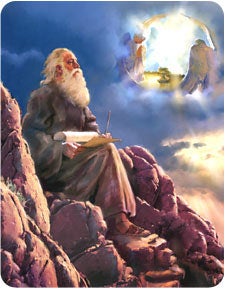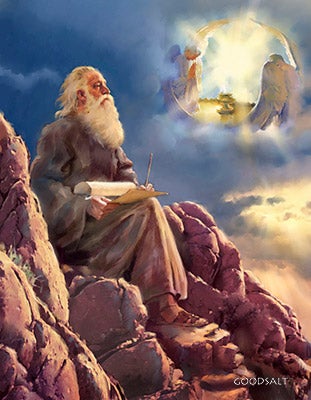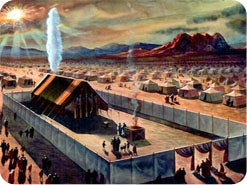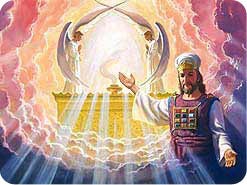 Lesson 15
Lesson 15
Never before had the Lord manifested such mighty signs and wonders as when He delivered the children of Israel from slavery in Egypt. Plague after plague fell upon the Pharaoh's kingdom until he was forced to release his captives. Then the Lord parted the Red Sea and led the young nation to freedom, while drowning their pursuing enemies behind them.
After entering the wilderness, God surprised many of His people by leading them south in the opposite direction of the Promised Land. The Lord knew that before they would be prepared to receive their inheritance, they must be organized and taught to trust Him. As they journeyed to Mount Sinai, God supplied their every need. When they became hungry, God fed them with bread from heaven. When they became thirsty, the Lord brought water cascading from a boulder. When suddenly attacked from behind by an enemy, they were given a miraculous victory.
Finally, the Israelites camped at the base of the holy mountain. There God did something He has not done before or since. He spoke, in the hearing of a whole nation, His covenant, the Ten Commandments. After the Lord audibly spoke His law, He called Moses up Mount Sinai to receive a transcript written in stone. But God also gave him something else. While on the mountain with the Lord for 40 days and 40 nights, Moses received detailed instructions to build a beautiful, portable temple for God. It would be a small model of His actual dwelling place in heaven. This unique structure was to serve as a three-dimensional object lesson to the whole world of God's plan to save us from sin.

1. What did God ask Moses to build, and why?
_____ Answer
2. What did God expect His people to learn from the sanctuary and its services?
_____ Answer
NOTE: God's way, or plan, of salvation was revealed in the earthly sanctuary. Everything in the sanctuary, or connected with its services, was a symbol of something Jesus would do in saving us. We cannot fully comprehend the plan of salvation until we understand the sanctuary and its services. It was a huge, 3-D object lesson explaining the process of salvation.3. Where did Moses obtain the blueprints for the sanctuary?
_____ Answer
NOTE: The sanctuary blueprints, with full specifications for its construction, were given to Moses by God on Mount Sinai (Hebrews 8:5). This was to be a microcosm of God's genuine sanctuary in heaven.
The first sanctuary, or tabernacle, was an elegant, tent-type structure (15 feet by 45 feet, based on an 18-inch cubit). There the supernatural presence of God dwelt and special services were conducted. The walls were made of upright acacia wood boards set in silver sockets and overlaid with gold (Exodus 26:15-19, 29). The roof was made of four layers of coverings--linen, goats' hair, rams' skins dyed red, and badgers' skins (verses 1, 7, 14). It had two rooms: the holy place (15 feet by 30 feet), and the most holy place (15 feet by 15 feet.). Refer often to the above diagram as you review this lesson.4. What furniture was in the courtyard?
_____ Answer
NOTE: : The altar of burnt offerings (Exodus 27:1-8) is where animals were sacrificed. It was located in the courtyard just outside the entrance of the sanctuary. This altar represented the cross of Christ. The sacrificial animal represented Jesus, the ultimate sacrifice (John 1:29). The laver (Exodus 30:17-21; 38:8) was a large wash basin of brass located between the entrance of the sanctuary and the altar of burnt offerings. There priests washed their hands and feet before entering the sanctuary or offering a sacrifice. The water represented baptism, cleansing from sin, and the new birth.5. What three items of furniture were in the holy place?
_____ Answer
NOTE: The table of shewbread (Exodus 25:23-30) represented Jesus, the living bread (John 6:51). The seven-branch candlestick (Exodus 25:31-40) represented Jesus, the light of the world (John 9:5; 1:9). The lamps of oil symbolized the Holy Spirit (Zechariah 4:1-6; Revelation 4:5). The altar of incense (Exodus 30:1-8) represented the prayers of God's people (Hebrews 5:7).6. What special article was in the most holy place?
_____ Answer
NOTE: The only object in the most holy place (Exodus 25:10-22) was the ark of the testimony, a chest of acacia wood overlaid with gold. Atop the chest were two angels made of solid gold. The cover of the ark was called the mercy seat (Exodus 25:17-22), where God's presence dwelt. This spot symbolized God's throne in heaven, which is likewise located between two angels (Psalms 80:1, Isaiah 6:1, 2).7. What was inside the ark?
_____ Answer
NOTE: God wrote His covenant with His own finger on two tables of stone, and they were placed inside the ark. The mercy seat was above them, which signified that as long as God's people confessed and forsook their sins (Proverbs 28:13), mercy would be extended to them through the blood that was sprinkled on the mercy seat by the priest (Leviticus 16:15, 16). That blood represented the blood shed by Jesus to bring all people forgiveness and cleansing (Matthew 26:28; Hebrews 9:22).8. Why did animals need to be sacrificed in the Old Testament sanctuary services?
_____ Answer
NOTE: Sacrificing animals was necessary to help people understand that without the blood of Jesus shed on the cross, there could be no forgiveness of sin. The shocking truth is that the punishment for sin is death. Since all of us have sinned, we should all die--and we would have died, except that Jesus gave His perfect life by dying in our behalf to pay for our sins. The sinner brought his own sacrificial animal and slew it with his own hand (Leviticus 1:4, 5). It was bloody and shocking, impressing people with the solemn truth that sin caused Jesus' death. Thus, they looked forward to the cross for salvation, while we look back to the cross for salvation. There is no other source of salvation.9. When animals were sacrificed for sin, what happened to the sin?
_____ Answer
NOTE: When the sinner placed his hands on the head of the animal and confessed his sins, the sins were symbolically transferred from the sinner to it. Thus, the animal became guilty and had to pay the death penalty. This represented Jesus bearing our sins.10. When a sacrificial animal was offered for the entire congregation, what happened to the sin?
_____ Answer
NOTE: The priest sprinkled some of the blood before the veil inside the sanctuary, thus symbolically transferring the sin from the people to the sanctuary. When Jesus ascended to heaven after His death, He offered His blood (as did the high priest of old) to show that our sins are forgiven when confessed in Jesus' name (1 John 1:9).11. What two sanctuary symbols does Jesus fulfill for us?
_____ Answer
NOTE: Jesus serves as the sacrifice for our sins and as our heavenly high priest, thus accomplishing two miraculous things for us. The first is a complete life change called the new birth, with all the sins of the past forgiven (John 3:3-6; Romans 3:25). The second is power to live right in the present and future (Titus 2:14; Philippians 2:13). These two things make a person righteous, which means a right relationship exists between that person and God. There is no way for a person to become righteous by works (his own efforts), because righteousness comes from grace that only Jesus can supply (Acts 4:12). This is righteousness by faith, which is the only true form of righteousness.12. What six wonderful promises does the Bible give us about the righteousness offered us by Jesus?
_____ Answer
NOTE: Jesus is ready to fulfill all of these glorious promises in your life. Are you ready? Kneel down now and ask Him to take control of your life. He will not fail you.13. Does a person have any role to play in becoming righteous?
_____ Answer
NOTE: Yes, our role is to turn our hearts and will over to Jesus and permit Him to rule. We must trust Him with full control of our lives. Many believe that Jesus will take all who merely profess His name to heaven, regardless of their conduct. But this deadly belief is not true (Matthew 7:14).14. What happened on the day of atonement?
_____ Answer
NOTE: The day of atonement was a solemn day of judgment that took place in Israel once each year (Leviticus 23:27). Every sin had to be confessed and forsaken. Those who refused were on that very day cut off forever from the camp of Israel (verse 29). On that day, two goats were selected. One was the Lord's goat and the other was the scapegoat, which represented Satan (Leviticus 16:7, 8). The Lord's goat was slain and offered for the sins of the people (verse 9). Its blood was taken into the most holy place and sprinkled upon and before the mercy seat (verse 14).
Only on this special judgment day did the high priest enter the most holy place. The sprinkled blood (representing Jesus' sacrifice) was accepted by God, and the confessed sins of the people were transferred from the sanctuary to the high priest.
He then transferred these confessed sins to the scapegoat, which was led into the wilderness and abandoned (verses 16, 20, 22). In this manner, the sanctuary was symbolically cleansed from the sins of the people, which had been transferred there by the sprinkled blood all throughout the previous year.
15. Did the old day of atonement foreshadow a cleansing of the heavenly sanctuary?
_____ Answer
NOTE: Yes! That day's services pointed to the blotting out of sin by Jesus, our high priest in the heavenly sanctuary. He is there to mediate for His people and stands ready to blot out the sins of all who will exercise faith in His shed blood. The ancient day of atonement, like modern Israel's Yom Kippur, foreshadowed the final atonement to be made for planet Earth. The final atonement leads to the final judgment, which will forever settle the sin question in the life of every individual. Our next lesson shows how God set the date for the heavenly judgment to begin. Exciting!16. Are you willing to place your life fully in Jesus' hands so He can work the miracles needed to make you righteous?
_____ Answer